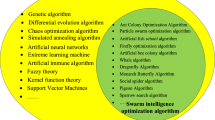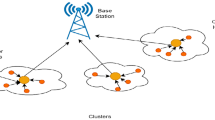Abstract
Partition of networks into optimal set of clusters is the prominent technique to prolong the network lifetime of energy constrained wireless sensor networks. Enumeration search method cannot find optimal clusters within polynomial bounded time for large scale networks since the computational complexity of problem grows exponentially with the dimension of networks. Optimal cluster configuration in sensor networks is known to be Non-deterministic Polynomial (NP)-hard optimization problem and for that reason we have applied polynomial time metaheuristic algorithms to find optimal or near-optimal solutions. In this paper, we present clustering algorithms based on Simulated Annealing (SA) and Particle Swarm Optimization (PSO) to find optimal set of cluster heads in the network. The optimization problem consists of finding optimal configuration of clusters such that the communication distance per cluster is not only minimized but the cluster balance and energy efficiency is also maintained in the network. The SA and PSO toolboxes are developed in C++ and integrated with OMNeT++ simulation environment to implement the proposed clustering algorithms. The performance of algorithms with respect to network lifetime, load balance and energy efficiency of network is examined in the simulation.






Similar content being viewed by others
References
Akyildiz, I. F., Su, W., Sankarasubramaniam, Y., & Cayirci, E. (2002). Wireless sensor networks: a survey. Journal of Computer Networks, 38(4), 393–422.
Gandham, S., Musunuri, R., Rentala, P., & Saxena, U. (2004). A survey on self-organizing wireless sensor networks. In R. Zurawski (Ed.), The industrial information technology handbook (pp. 78.1–78.16). Boca Raton: CRC Press.
Butun, I., Morgera, S. D., & Sankar, R. (2013). A survey of intrusion detection systems in wireless sensor networks. IEEE Communications Surveys and Tutorials, 16(1), 266–282.
Yu-Lin, T., & Berber, S. (2011). Design, development and testing of a wireless sensor network for medical applications. In Proceedings international conference on wireless communications and mobile computing, pp. 826–830.
Papadopoulos, G. (2015). Challenges in the design and implementation of wireless sensor networks: A holistic approach-development and planning tools, middleware, power efficiency, interoperability. In Proceedings Of Mediterranean Conference On Embedded Computing, pp. 1–3.
Chong, C. Y. & Kumar, S.P. (2003). Sensor networks: evolution, opportunities, and challenges. In Proceedings of IEEE, pp. 1247–1256.
Goldsmith, A. J., & Wicker, S. B. (2002). Design challenges for energy constrained ad hoc wireless networks. IEEE Wireless Communications, 9(4), 8–27.
Buttyan, L., Gessner, D., Hessler, A., & Langendoerfer, Peter. (2010). Application of wireless sensor networks in critical infrastructure protection: challenges and design options (security and privacy in emerging wireless networks). IEEE Wireless Communications, 17(5), 44–49.
Younis, O., Krunz, M., & Ramasubramanian, S. (2006). Node clustering in wireless sensor networks: recent developments and deployment challenges. IEEE Network, 20(3), 20–25.
Bari, A., Jaekel, A., & Bandyopadhyay, S. (2008). Clustering strategies for improving the lifetime of two-tiered sensor networks. Computer Communications, 31(14), 3451–3459.
Abbasi, A. A., & Younis, M. (2007). A survey on clustering algorithms for wireless sensor networks. Computer Communications, 30(14–15), 2826–2841.
Al-Karaki, J. N., & Kamal, A. E. (2004). Routing techniques in wireless sensor networks: a survey. IEEE Wireless Communications, 11(6), 6–28.
Heinzelman, W.R., Chandrakasan, A., & Balakrishnan, H. (2000). Energy efficient communication protocol for wireless microsensor networks. In Proceedings of IEEE Hawaii International Conference On System Sciences, pp. 3005–3014.
Heinzelman, W. R., Chandrakasan, A., & Balakrishnan, H. (2002). Application specific protocol architecture for wireless microsensor networks. IEEE Transactions on Wireless Communications, 1(4), 660–670.
Ruela, A.S., Cabral, R.S, Aquino, A.L.L., & Guimaraes, F.G. (2009). Evolutionary design of wireless sensor networks based on complex networks. In Proceedings of International Conference On Intelligent Sensors, Sensor Networks and Information Processing (ISSNIP), pp. 237–242.
EkbataniFard, G.H., Monsefi, R., Akbarzadeh-T, M.R., & Yaghmaee, M.H. (2010). A multi-objective genetic algorithm based approach for energy efficient QoS-routing in two-tiered Wireless Sensor Networks. In Proceedings of IEEE International Symposium On Wireless Pervasive Computing, pp. 80–85.
Turgut, D., Turgut, B., Elmasri, R., & Le, T.V. (2003). Optimizing clustering algorithm in mobile ad hoc networks using simulated annealing. In Proceedings of IEEE International Conference On Wireless Communications and Networking, pp. 1492–1497.
Latiff, N.M.A., Tsimenidis, C.C., & Sharif, B.S. (2007). Energy-Aware Clustering for Wireless Sensor Networks using Particle Swarm Optimization. In Proceedings of IEEE International Symposium On Personal, Indoor and Mobile Radio Communications, pp. 1–5.
Halgamuge, M. N., Zukerman, M., Ramamohanarao, K., & Vu, H. L. (2009). An estimation of sensor energy consumption. Progress in Electromagnetics Research B, 12, 259–295.
Randrianarisaina, A.A., Pasquier, O., & Charge, P. (2013). A function approach for simple wireless sensor node energy consumption modeling. In Forum on Specification & Design Languages (FDL), pp. 1–8.
Wang, A., & Chandrakasan, A. (2002). Energy-efficient DSPs for wireless sensor networks. IEEE Signal Processing Magazine, 19(4), 68–78.
Smithgall, D. (1998). Toward the 60 gm wireless phone. In Proceedings of the 1998 Radio and Wireless Conference (RAWCON).
Rappaport, T. S. (1996). Wireless communications: principles and practice. Englewood Cliffs: Prentice-Hall.
Zhu, J., & Papavassiliou, S. (2003). On the energy-efficient organization and the lifetime of multi-hop sensor networks. IEEE Communication Letters, 7(11), 537–539.
Mille, M. J., & Vaidya, N. F. (2005). A MAC protocol to reduce sensor network energy consumption using a wakeup radio. IEEE Transactions on Mobile Computing, 4(3), 228–242.
Van Laarhoven, P. J. M. (1988). Theoretical and computational aspects of simulated annealing. Rotterdam: Erasmus Universiteit Rotterdam.
Panigrahi, B. K., Shi, Y., & Lim, M. H. (2011). Handbook of swarm intelligence: Concepts, principles and applications (pp. 3–292). Berlin: Springer.
The Network Simulator. http://www.omnetpp.org/.
Author information
Authors and Affiliations
Corresponding author
Rights and permissions
About this article
Cite this article
Mekonnen, M.T., Rao, K.N. Cluster Optimization Based on Metaheuristic Algorithms in Wireless Sensor Networks. Wireless Pers Commun 97, 2633–2647 (2017). https://doi.org/10.1007/s11277-017-4627-z
Published:
Issue Date:
DOI: https://doi.org/10.1007/s11277-017-4627-z




